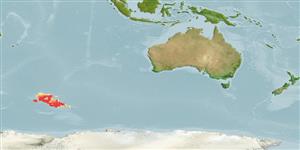Common names from other countries
Environment: milieu / climate zone / depth range / distribution range
Ecology
Marine; demersal; depth range 1 - 750 m (Ref. 11892). Polar; 46°S - 57°S, 61°E - 83°E
Southern Ocean: endemic to the Kerguelen-Heard Plateau, Antarctica.
Size / Weight / Age
Maturity: Lm ? range ? - ? cm
Max length : 60.0 cm TL male/unsexed; (Ref. 2805); common length : 40.0 cm TL male/unsexed; (Ref. 2805); max. published weight: 500.00 g (Ref. 4883)
Adults are found from near shore to farther than 750 m. Feed mainly on fishes and occasionally on algae.
Hureau, J.-C., 1985. Channichthyidae. p. 261-277. In W. Fischer and J.C. Hureau (eds.) FAO species identification sheets for fishery purposes. Southern Ocean (Fishing areas 48, 58 and 88). Rome. Vol. 2. (Ref. 2805)
IUCN Red List Status (Ref. 130435)
CITES (Ref. 128078)
Not Evaluated
Threat to humans
Harmless
Human uses
Fisheries: commercial
Tools
Special reports
Download XML
Internet sources
Estimates based on models
Preferred temperature (Ref.
115969): 1.3 - 2.5, mean 1.8 (based on 23 cells).
Phylogenetic diversity index (Ref.
82804): PD
50 = 0.5020 [Uniqueness, from 0.5 = low to 2.0 = high].
Bayesian length-weight: a=0.00126 (0.00058 - 0.00275), b=3.47 (3.29 - 3.65), in cm Total Length, based on LWR estimates for this (Sub)family-body shape (Ref.
93245).
Trophic level (Ref.
69278): 3.3 ±0.54 se; based on food items.
Resilience (Ref.
120179): Medium, minimum population doubling time 1.4 - 4.4 years (Assuming tm=4; Fec = 2,770).
Fishing Vulnerability (Ref.
59153): Moderate vulnerability (44 of 100).
Climate Vulnerability (Ref.
125649): High to very high vulnerability (73 of 100).
